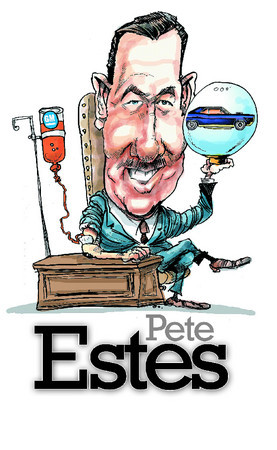Pete Estes boosted Pontiac’s reputation with the GTO
Some lives turn on a dime.
Elliott "Pete" Estes, an engineer at heart, could see the wheels spinning that morning in 1963 when a bright account executive for Pontiac's advertising agency walked through the door with a notion that would ultimately ignite the "muscle car" era.
Estes could see the potential in secretly creating the GTO, a car that would eventually become the subject of songs, movies and passionate car clubs from Detroit to Dallas.
But, then, Estes could see a lot of things before they happened.
It's that kind of brilliance that would take him from the engineering offices of Chevrolet and Pontiac all the way to the top of General Motors Corp.
His hands-on approach won over dealers. His leadership energized a division. His vision led a corporation to profitability.
Pete Estes knew how to water, nurture and allow ideas to grow. He knew about life's quick turns.
"You knew immediately that he was someone who wasn't afraid to try something different," Estes' longtime co-worker Semon "Bunkie" Knudsen once said.
But back to that dime ...
The conversation began innocently enough. It was early 1963 and after years working his way through the ranks, Estes was Pontiac's general manager. He knew the division needed a blast of energy and set out to assemble a team to make it happen.
Jim Wangers, the account executive at the advertising agency of MacManus, John and Adams, knew that GM's mandate to pull out of all forms of factory-backed racing in 1963 wouldn't help the company attract young buyers. Wangers' idea was to swap an engine from a full-size Pontiac into the midsized body of the Tempest. The car, named the GTO after Ferrari's GTO (Gran Turismo Omologato), also received a number performance upgrades, including a heavy-duty suspension.
"It's an old hot-rodder's trick, but I think it could work," Wangers said that day.
Estes outlined the plan. The 1964 GTO was born and the rest was history. The original production plans called for about 5,000 units; Pontiac sold more than 30,000 the first model year. Sales topped 97,000 units just two years later.
The GTO was the right product at the right time, but Estes was just getting rolling. His ability to spot a trend and ride it would eventually take him to the top.
Born Jan. 7, 1916, in Mendon, Mich., Estes was a car guy practically from birth. He graduated from the General Motors Institute in 1938 and then attended the University of Cincinnati where he received a degree in mechanical engineering.
Estes began as a young engineer at Oldsmobile in Lansing, Mich., where he helped develop a high-compression engine in 1949.
While at Olds, Estes' life took its real first turn.
Knudsen had just been given the reins at Pontiac and he needed some fresh ideas and young minds to inject excitement into the brand.
A call was placed to Estes.
"Pete," Knudsen said, "I want you to come over here and help steer us on the right course."
Estes was a little hesitant about leaving Olds, at the time a successful GM division.
"After all," Estes said, "Olds was a fast stepper, while Pontiac certainly was not."
But Knudsen and GM styling vice president Harley Earl eventually convinced him to make the move.
"I just had all my Oldsmobile blood drained out one night," Estes remembered, "and had Pontiac blood pumped in the next morning. That's all there was to it."
Estes went to Pontiac as a chief engineer. It was the beginning of an era unequaled in recent automotive history.
Together with Knudsen, Pontiac and Estes were on their way up.
Over the years, Estes was instrumental in developing the "wide track" concept of the automobile (a wide stance for better handling and more interior room) and also working to equalize the weight distribution of an automobile by mounting the engine in the front and the transmission in the back.
But it was his leadership that truly shined through.
By 1974 he was elected the 15th president and chief operating officer of GM and held that position until his retirement in 1981.
"He was a brilliant automobile exec who understood the soul of the car industry," Nat Shulman, a Chevrolet dealer in Massachusetts, wrote about Estes in a story for Ward's, an industry trade paper.
Estes died in 1988 after only seven years in retirement, but not before leaving an indelible stamp on the automotive industry.
Pontiac even brought back the GTO name for the 2004 model year, touting that the muscle car had, indeed, returned. Expensive and loaded with features, it deviated from Estes formula of midsized muscle for the masses, especially young buyers, but the resurrection more than proved he was a man with vision and a plan that worked.
Jason Stein is a feature writer with Wheelbase Communications. He can be reached on the Web at www.wheelbase.ws/mailbag.html. Wheelbase Communications supplies automotive news and features to newspapers across North America.














